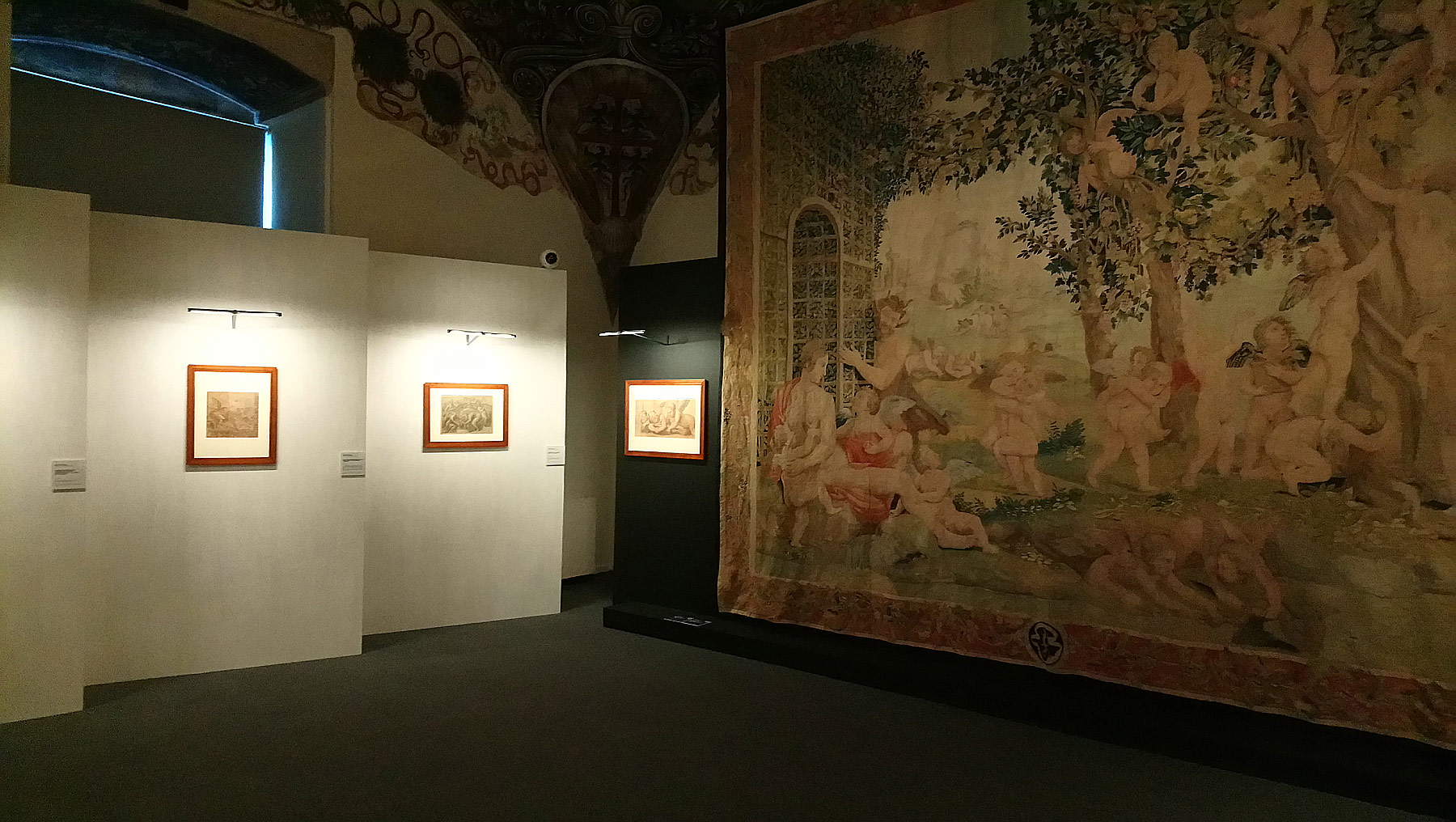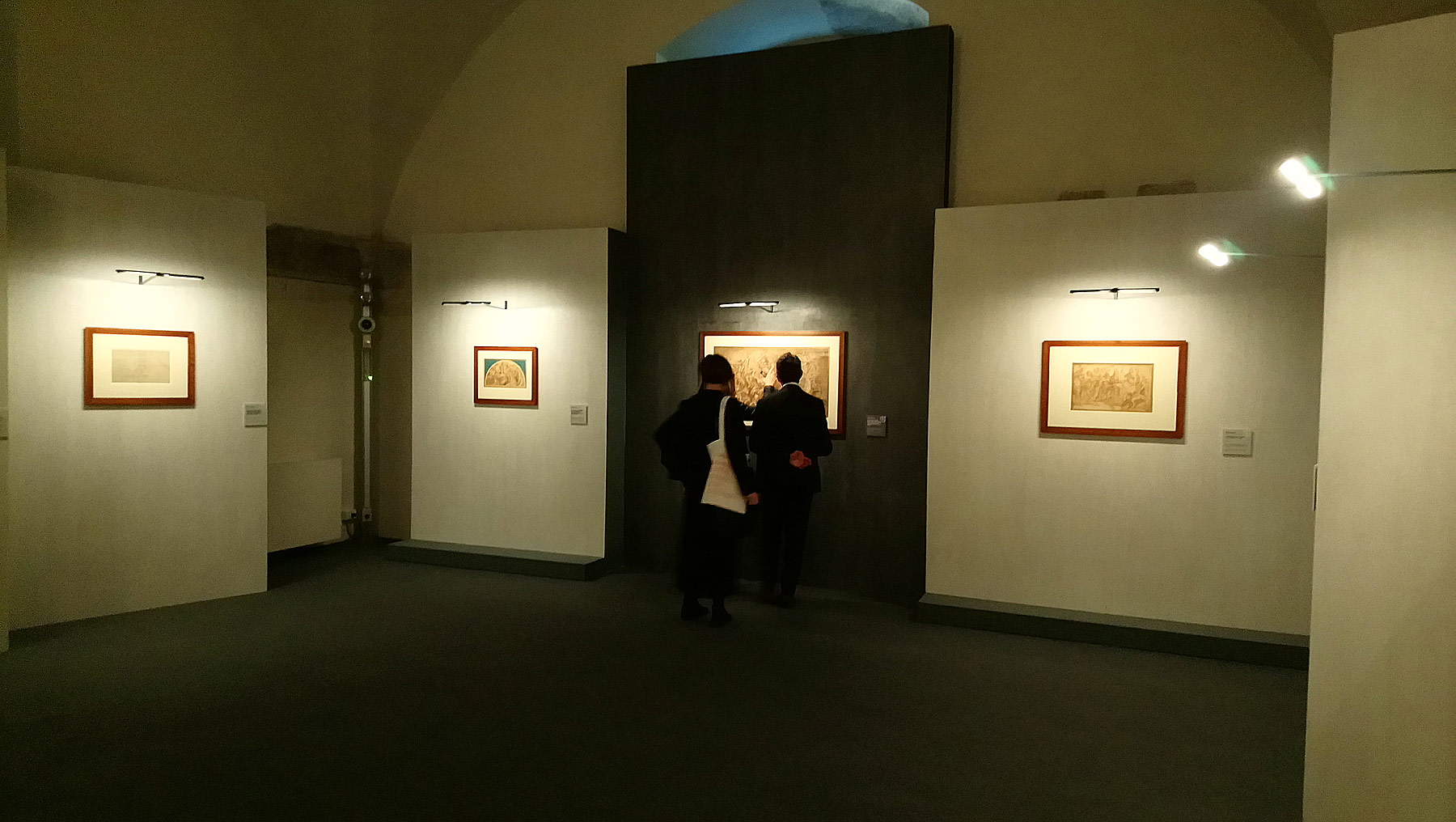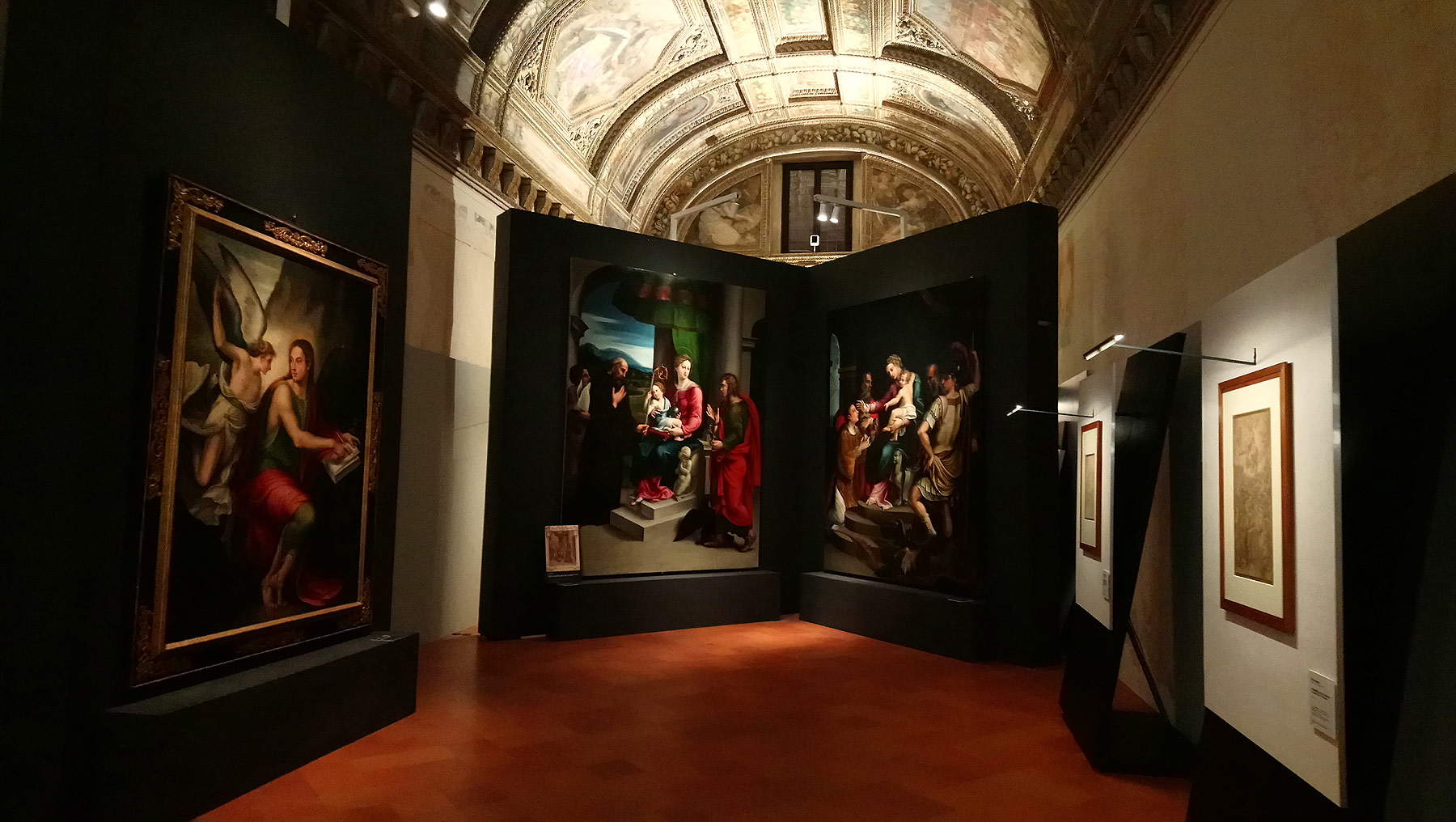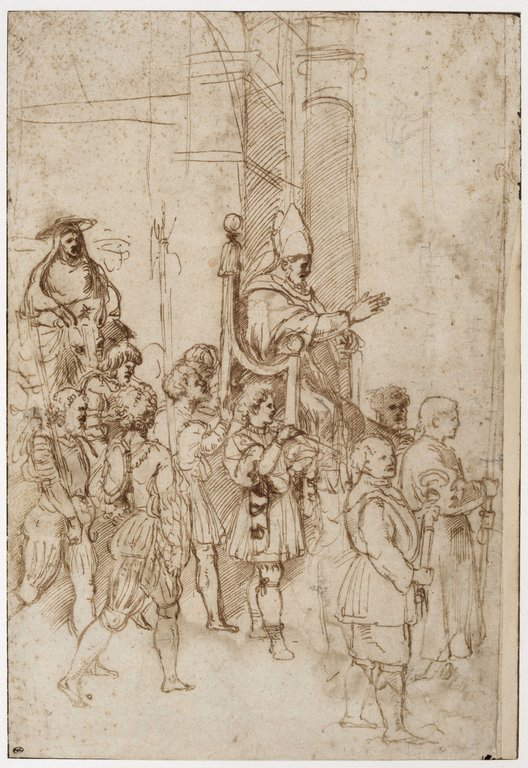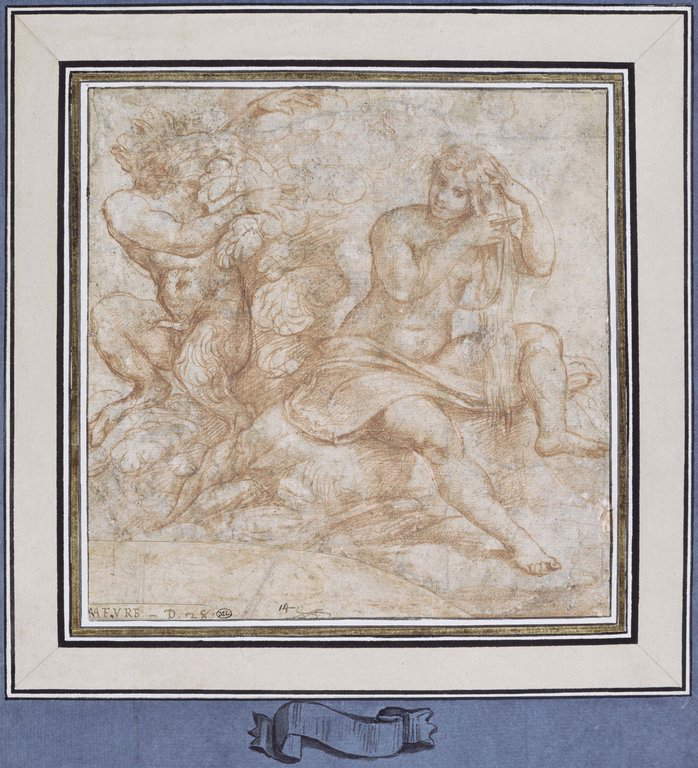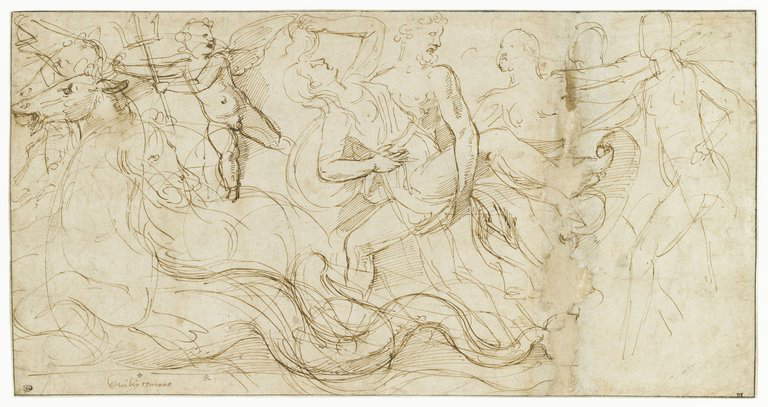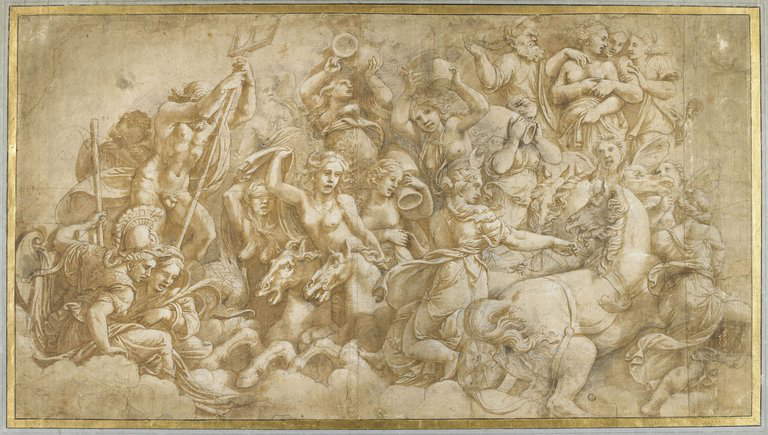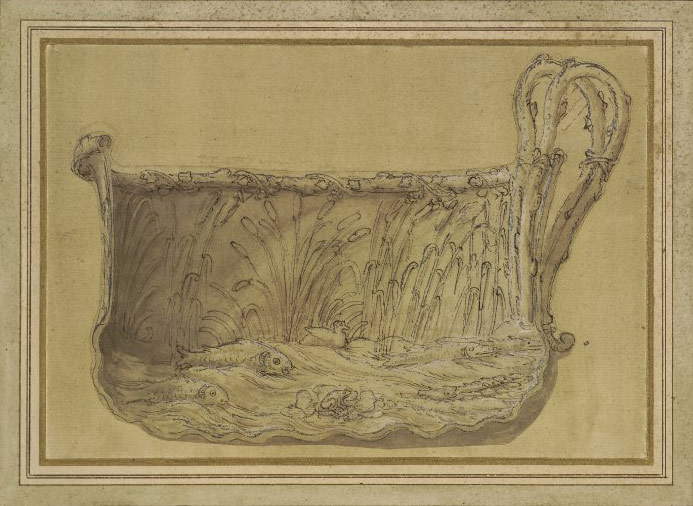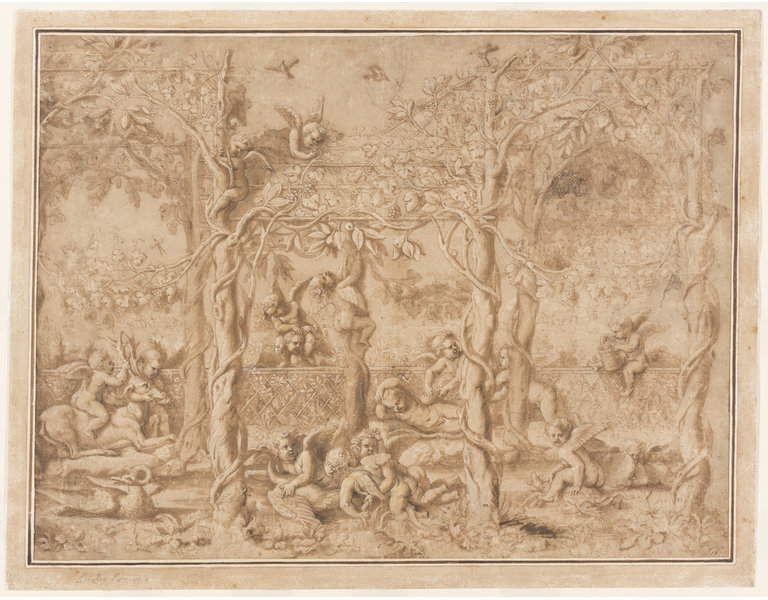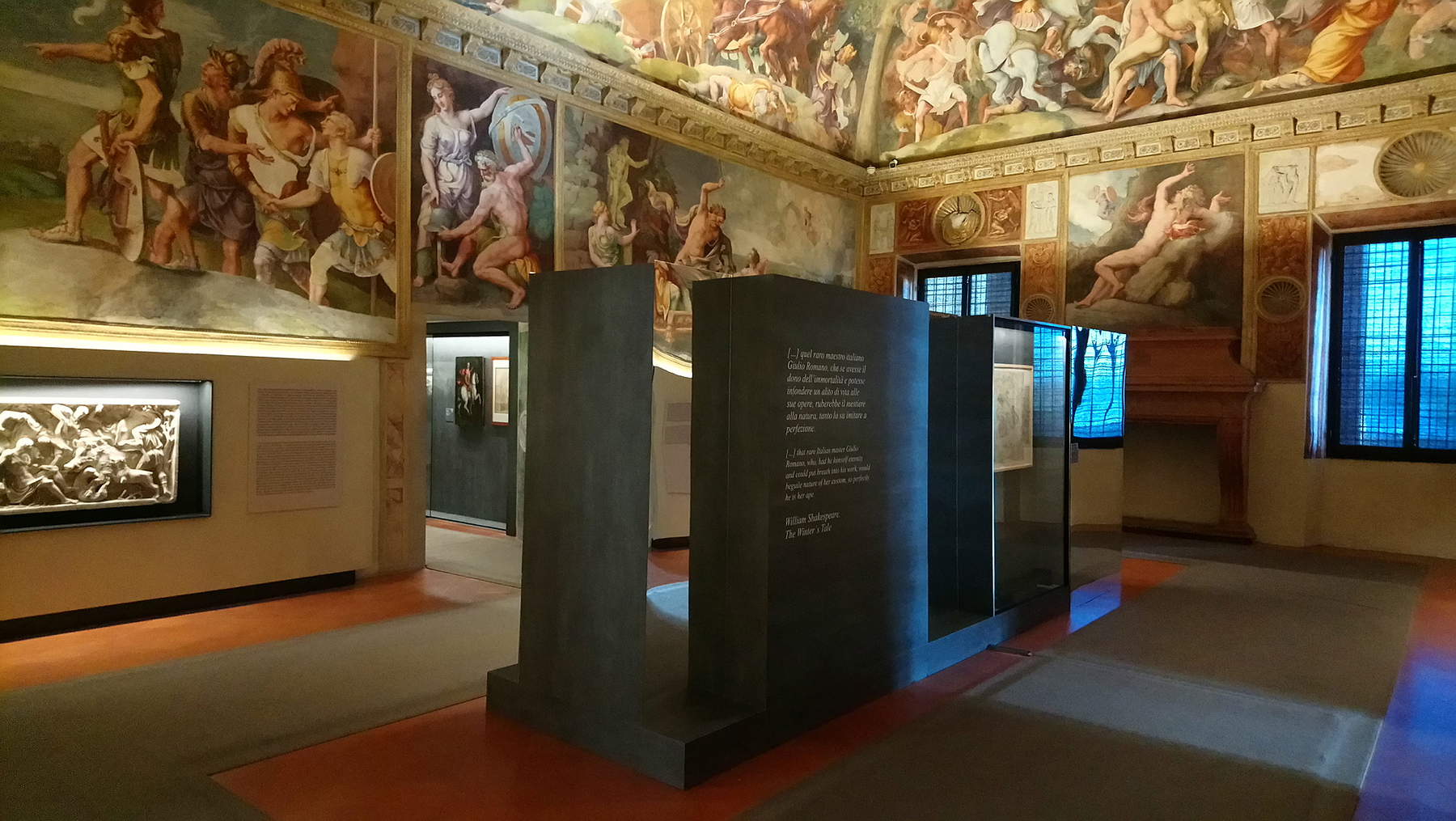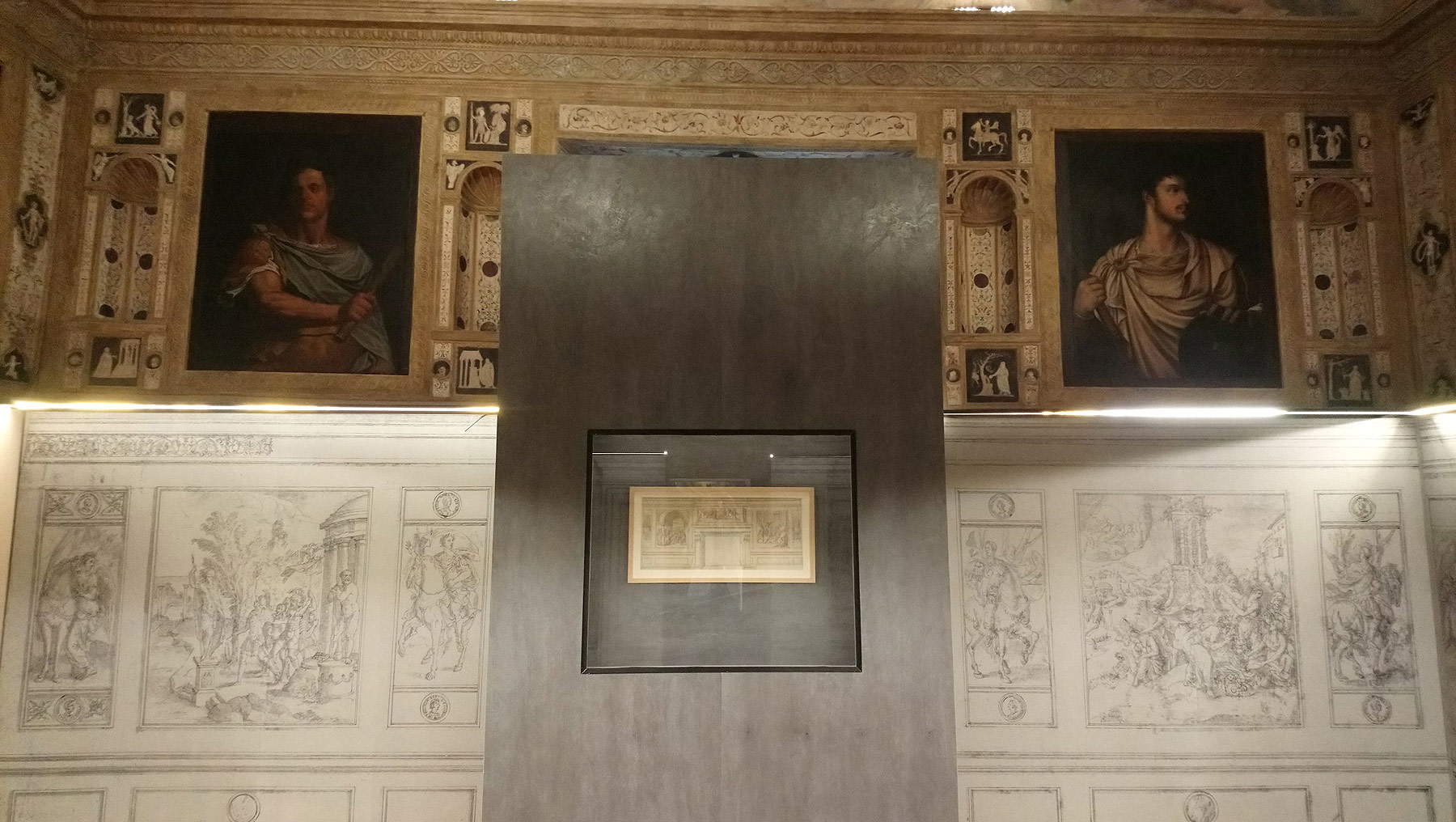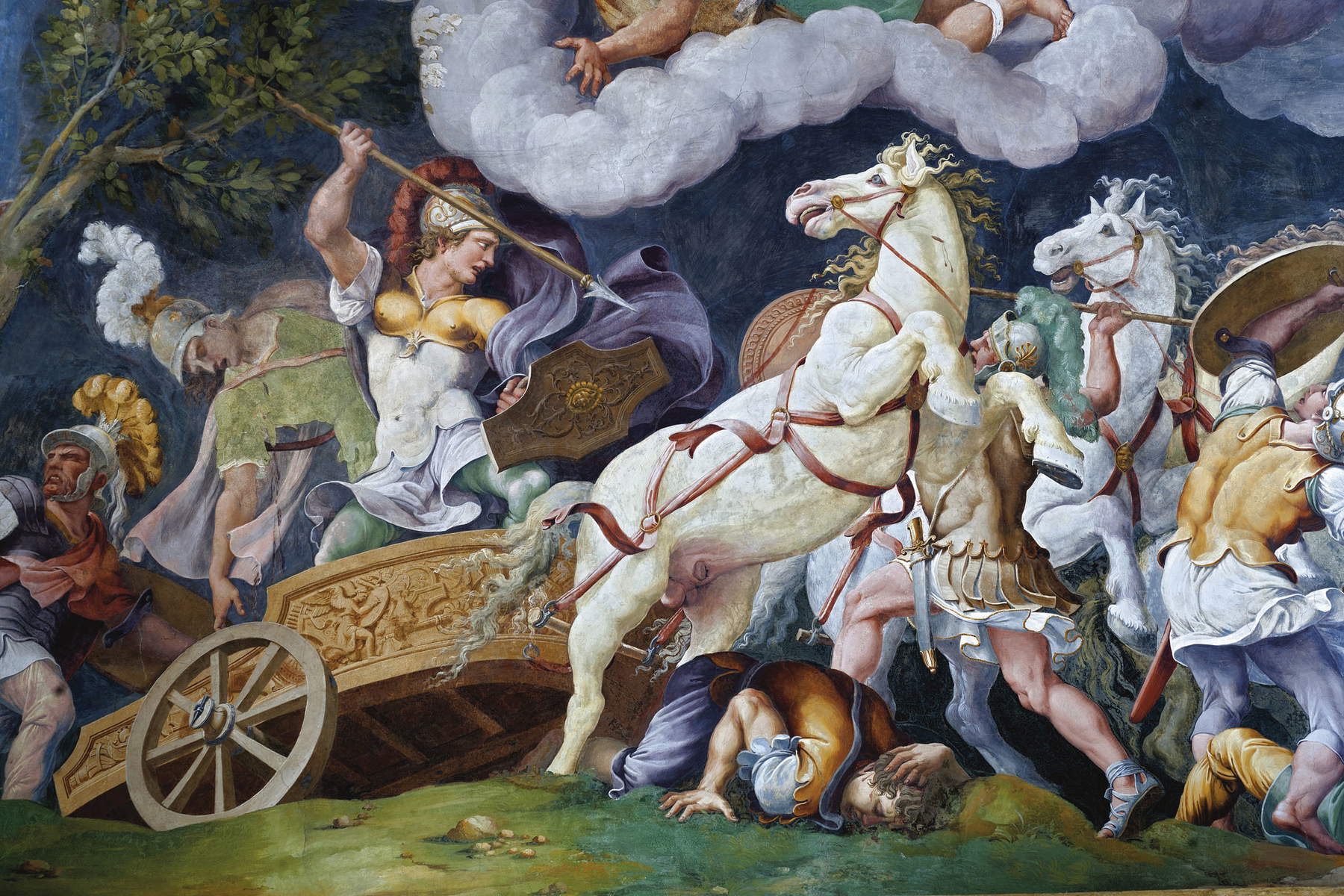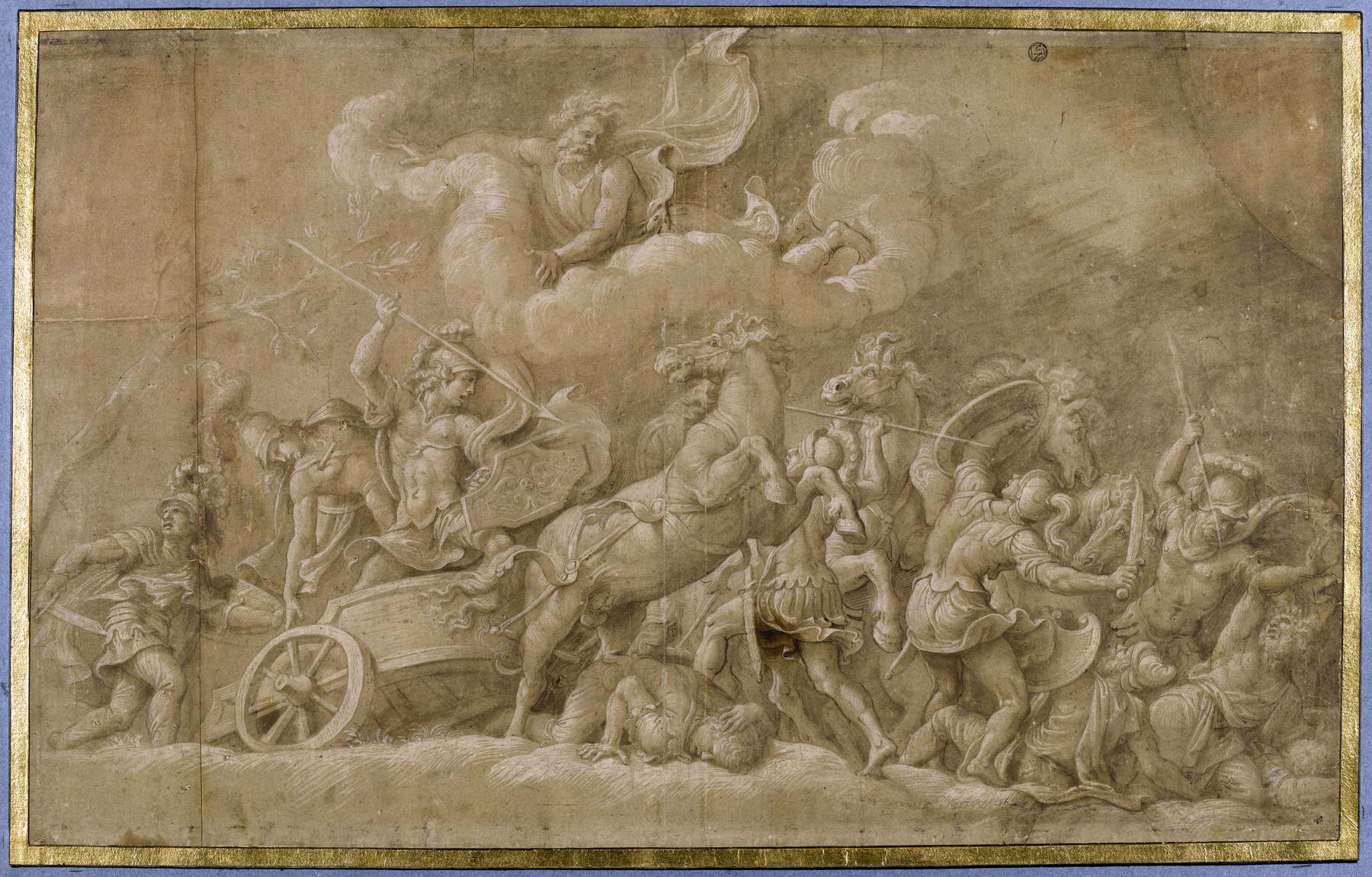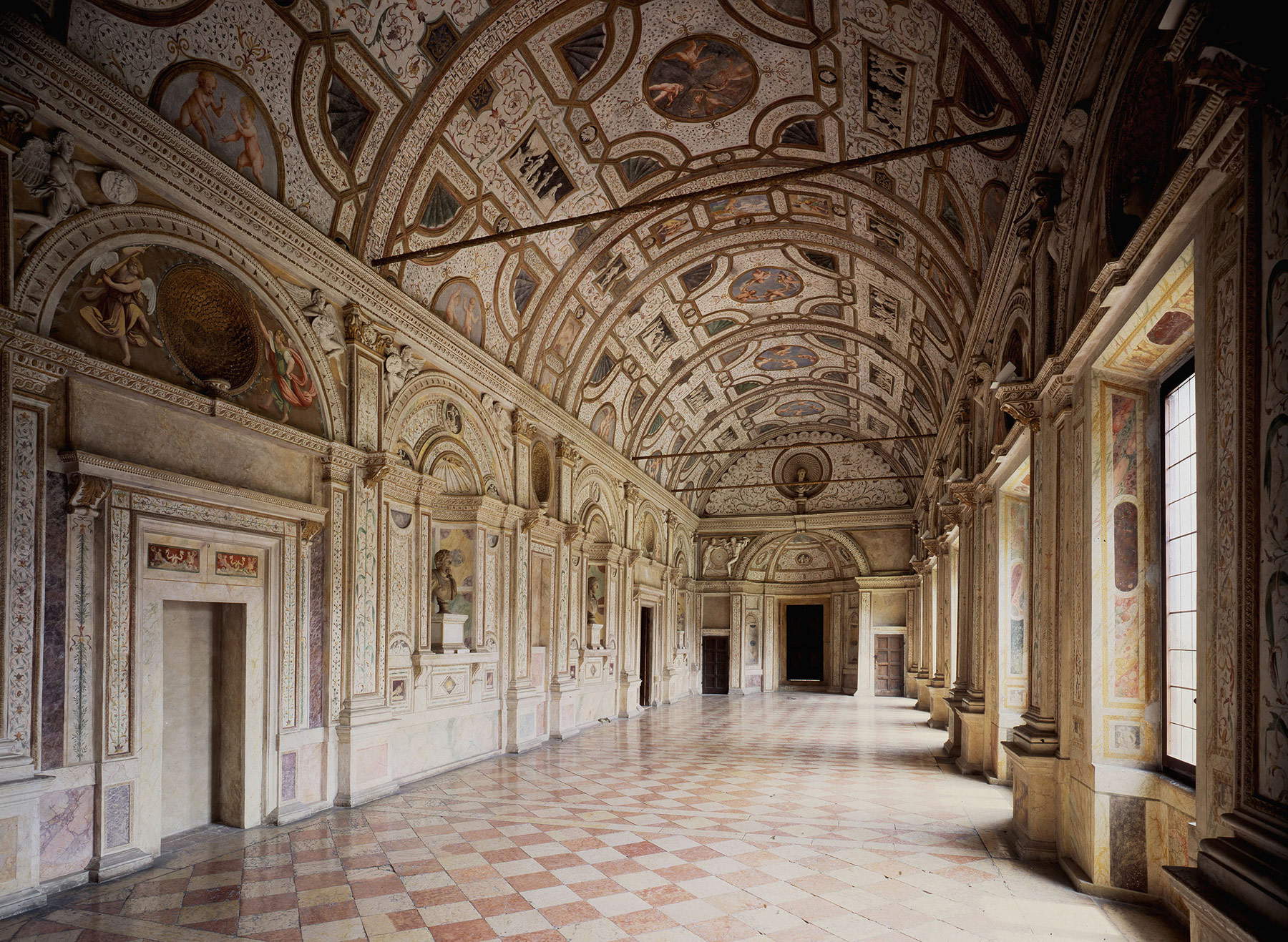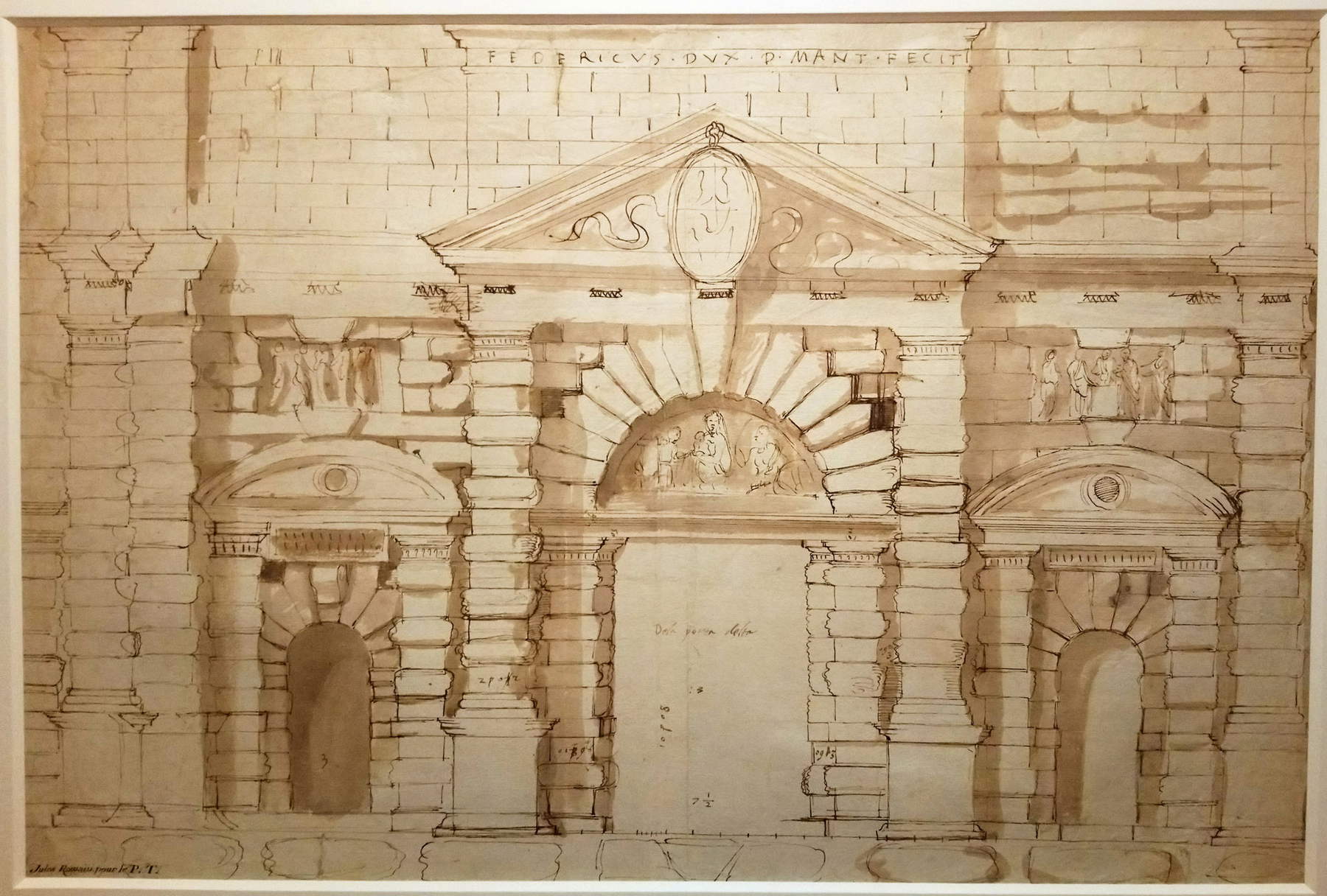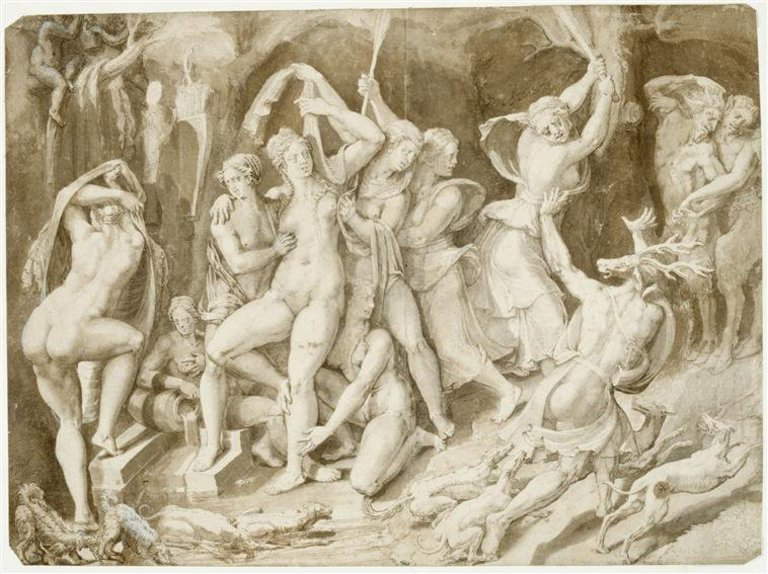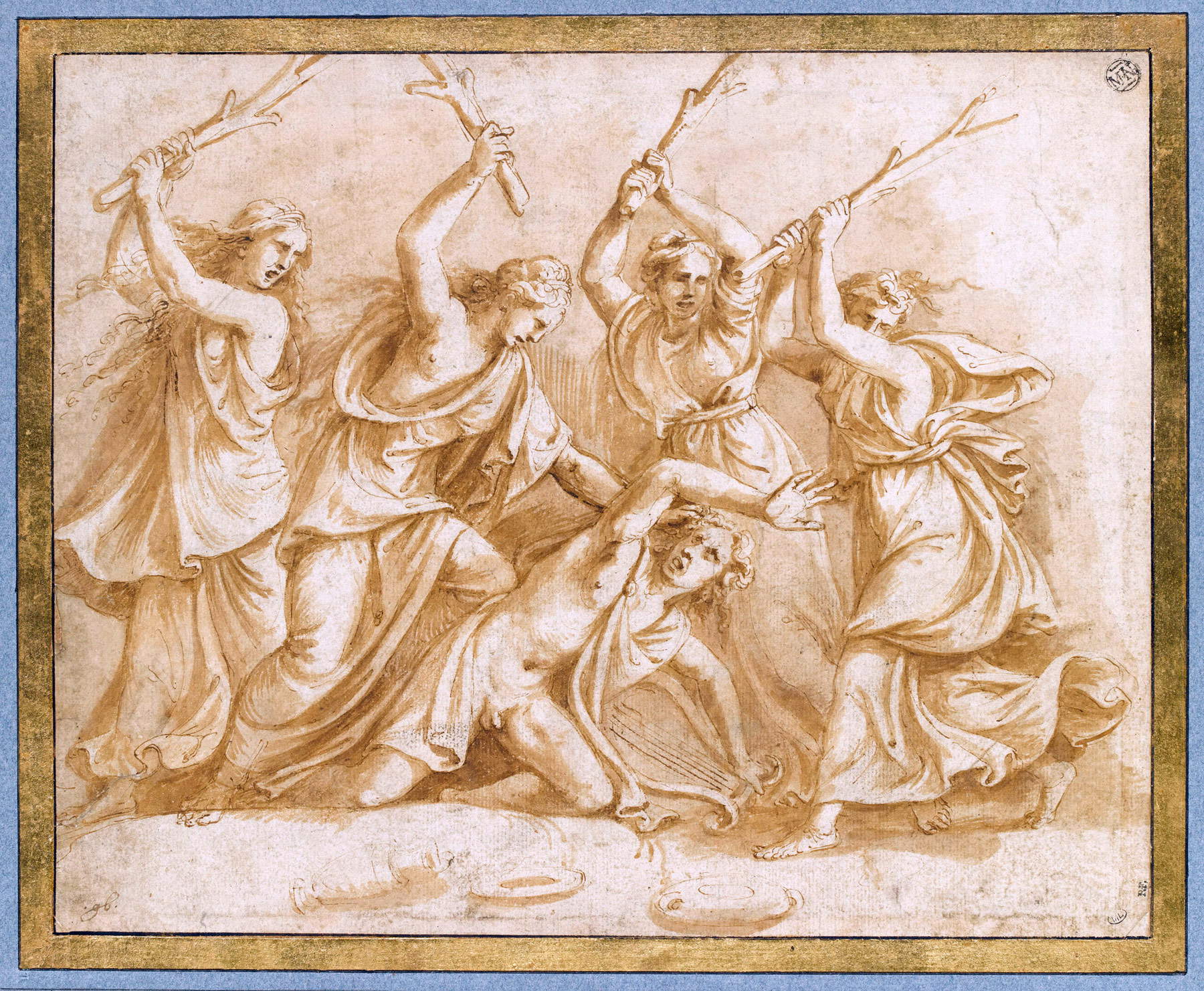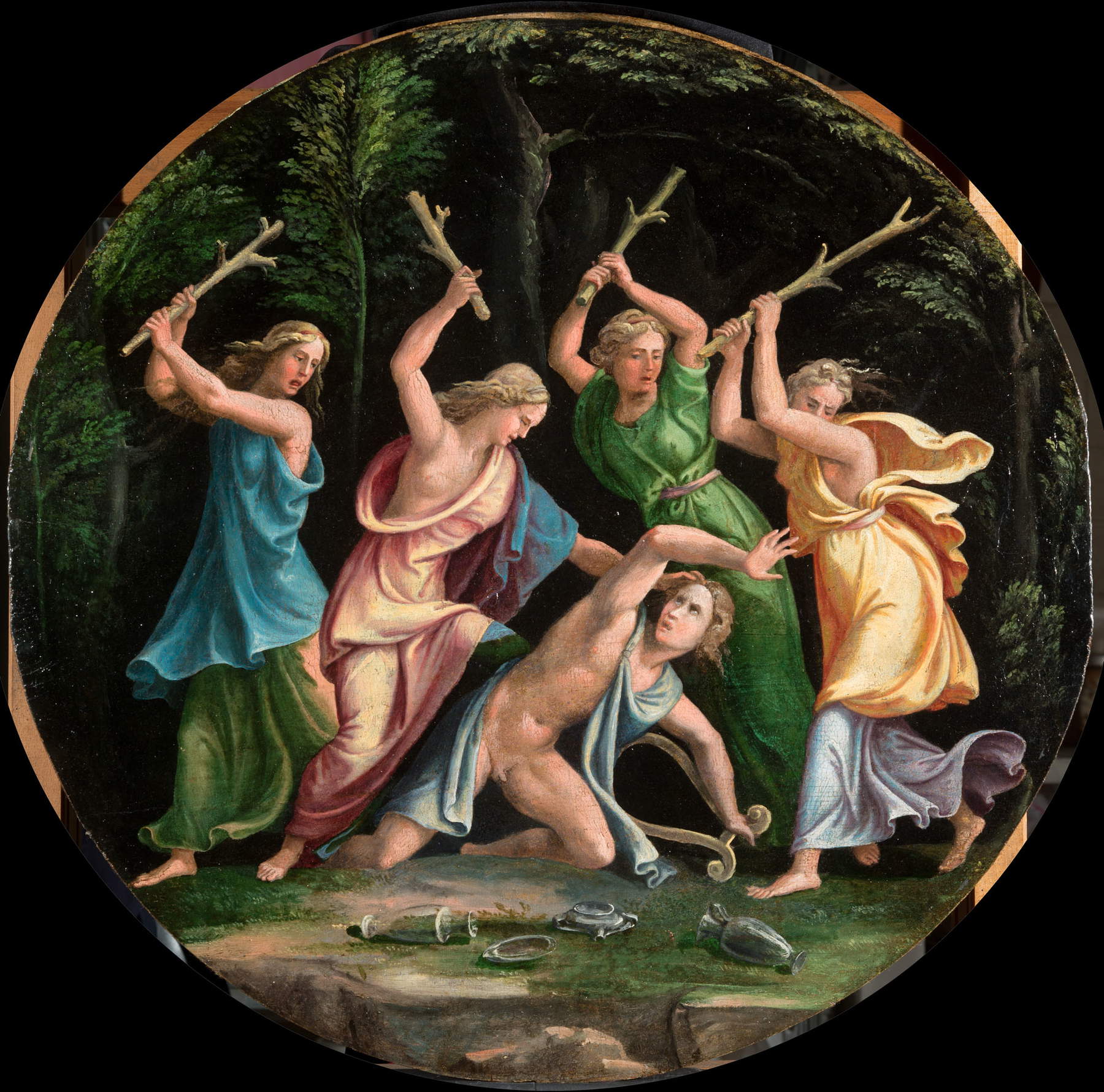by Federico Giannini (Instagram: @federicogiannini1), published on 05/12/2019
Categories: Exhibition reviews
/ Disclaimer
Review of the exhibition "'Con nuova e stravagante maniera'. Giulio Romano in Mantua" (in Mantua, Ducal Palace, until January 6, 2020)
More than 270,000 visitors were counted when the doors of the major exhibition on Giulio Romano (Giulio Pippi de’ Iannuzzi; Rome, c. 1499 - Mantua, 1546), which had begun just two months earlier, on September 1, 1989, closed at Palazzo Te in Mantua: the outstanding success of that extraordinary exhibition, curated by three experts of the highest caliber (Ernst Gombrich, Manfredo Tafuri and Christoph Frommel), was due to a combination of factors capable of leading us to define as unrepeatable that review, which required at least three years of preparation and involved an international scientific committee, composed of scholars who had already worked with profit and excellent results on Raphael’s great pupil. Meanwhile, Giulio Romano had until then enjoyed little consideration (especially among the general public), and the exhibition posed itself as an opportunity for the rediscovery of the artist. In addition, there was the opportunity to work on a large amount of unpublished material, an eventuality that allowed art historians to fix many points in Giulio Romano’s career (the research led to the publication, in 1992, of a Repertory of documentary sources edited by Daniela Ferrari and introduced by Amedeo Belluzzi, under the aegis of the Ministry). Many and important were the loans: the Two Lovers from the Hermitage, the Woman in the Mirror from the Pushkin Museum, the Hertz Madonna from the Barberini Palace, the Madonna of the Cat from Naples, the Portrait of a Young Man from the Thyssen-Bornemisza, not to mention the large number of drawings. Finally, consider that the exhibition came at the end of a vast restoration campaign that had affected Palazzo Te, which was reopened to the public for the occasion: one can therefore well imagine the general enthusiasm that had invested the city and beyond.
It was impossible to repeat a similar exhibition: therefore, the review that opened in Mantua, at Palazzo Ducale, thirty years after that event ("Con nuova e stravagante maniera. Giulio Romano in Mantua, through January 6, 2020) should not be measured by that yardstick, but rather for what it is: an exhibition on Giulio Romano’s activity as a draughtsman, with a few forays into the theme of the workshop and its students. In order to put it in its best context, it should be noted that it is an exhibition that has had a rather long and troubled gestation, the origins of which can be traced back many years, since already ten years ago the idea of organizing an exhibition on Giulio Romano in Mantua was being considered. For the project, which would undergo several changes of form over the years, a dialogue with the Louvre was already imagined (after all, it is the sheets of the Parisian institute that today largely support the exhibition at the Ducal Palace): moreover, in 2012, an exhibition of about forty sheets had been held at the French museum, curated by Laura Angelucci and Roberta Serra, both Italian scholars at the Louvre’s Graphic Arts Department and both curators of this year’s exhibition, together with Peter Assmann and Paolo Bertelli and with the collaboration of Michela Zurla. And a willingness to collaborate on a larger exhibition had emerged. In the meantime, in between, there has been everything: the repercussions of the economic crisis of 2007-2008, the Emilia earthquake that also affected the Ducal Palace, the reform, autonomy, the new management structure of the Ducal Palace, the succession of local administrations (at the beginning, in fact, it was imagined that an exhibition involving Palazzo Te would also be organized: as we can see, it has then come to be conceived this year as two totally separate exhibitions). The project has therefore slipped until this year.
The importance of the exhibition lies not so much in the novelty of the material as in the fact that many of the drawings brought to the Ducal Palace had never been exhibited before (the occasion is therefore useful for de visu comparisons never previously proposed), in the fact that it is possible to observe several sheets in the places for which Giulio Romano imagined the projects he had traced on paper, and in the extension of the section reserved for Giulio’s students: a work largely dependent on the numerous researches on the subject carried out by Stefano L’Occaso, which have found further accommodation in the very recent volume Giulio Romano “universale,” which was published this year and has provided a useful study tool.
 |
| Hall of the exhibition "Con nuova e stravagante maniera. Giulio Romano in Mantua |
 |
| Hall of the exhibition " Con nuovae stravagante maniera". Giulio Romano in Mantua |
 |
| Hall of the exhibition " Con nuovae stravagante maniera". Giulio Romano in Mantua |
The exhibition at the Ducal Palace is tripartite: the first section is entitled Il segno di Giulio (Giulio’s Sign), is set up on the first floor of the Castle of San Giorgio and is dedicated to the different themes of Giulio Romano’s graphic production. The second, Al modo di Giulio, unfolds between Corte Nuova and Appartamento di Troia, offering the public the chance to examine the drawings in relation to the spaces designed by Giulio. The third, In the manner of Julius, takes shape in the Rustica apartment and is in turn divided into two portions: on one side the Giulio Romano architect is investigated, and on the other the subject of his students is addressed. The itinerary opens with a room that examines the beginnings of Giulio Romano’s career in Raphael’s workshop, a subject to which Sylvia Ferino-Pagden (already a member of the 1989 exhibition’s scientific committee) also returns in her catalog essay: the scholar mentions two of the drawings with which the exhibition begins, namely the studies for the scene of the Donation of Constantine, destined to decorate one of the walls of the Hall of Constantine in the Vatican (which remained unfinished after Raphael’s death in 1520), taken as examples of Giulio Romano’s stroke, who precisely from what was left by his illustrious master developed the composition “with further rapid strokes of the pen, not enlarging or thinning the stroke, but doubling it, or accentuating the contours of the lines at certain points, multiplying them.” One gets the feeling of a drawing with a stroke that is “nervous, fluttering and almost in relief”: it is a Giulio Romano who does not deviate much from Raphael. There is also room in the exhibition for earlier evidence, such as the Pan e Siringa executed in preparation for the frescoes of Cardinal Bibbiena’s stove, and therefore based on a sketch by Raphael: the attribution to Giulio Romano (long disputed with Giovanni Francesco Penni, another young artist active in Urbino’satelier in those years) is motivated by the fact that the mark is repeated several times and that the work reveals some elements that can be traced back to Giulio’s manner (the sinuous figures, the strongly expressive faces).
If the “Roman” section is naturally poor, given that the artist left the then capital of the Papal States when he was not yet twenty-five years old (and let it be added that the Roman drawings are the most difficult to assign), the “Mantuan” nucleus is instead very rich, again by force of circumstance (from 1524 on, Giulio would never again leave the city of the Gonzagas). In the exhibition, the transition from Rome to Mantua is all too abrupt, and little light is shed on the context that the artist found upon his arrival in the marquisate: it is therefore hard to understand why the environment was so receptive to Giulio’s art, and why it was precisely in Mantua that many of the innovations that would later spread elsewhere from there could be elaborated. In Stefano L’Occaso’s recent monographic study, we read that Giulio found in Mantua “a city that could boast of some extremely innovative decorative solutions in the northern Italian panorama: in part these were Roman-inspired novelties, such as the grotesques and the ’marmo pesto’ stuccoes of the Scalcheria; in part, however, they were stylistic, formal and even compositional solutions of Po Valley or Veneto culture.” more in detail, Mantua was an artistically very open city (Correggio, Lorenzo Costa the Elder, Dosso Dossi, and most recently Lorenzo Leonbruno (Mantua, 1477 - 1537) had worked there), who, following a stay in Rome, imported grotesques and ornaments reminiscent of classical antiquities to his homeland. It is therefore easy to see how a pupil of Raphael such as Giulio Romano could fit relatively easily into an environment inclined to welcome novelties, all the more so if those novelties were elaborated by an artist of great talent and capable of continuous renewal. So much so that, in Mantua, Giulio would change his own way of drawing: what especially differentiates him from Raphael lies in the fact that Giulio is less interested than the master in the study of the individual figure. Indeed, detailed study of the latter is often absent as part of the creative process. The result is compositions that communicate a strong dynamism: “by using the stratagem of avoiding well-defined chiasms,” Ferino-Pagden writes, “he further reinforces the feeling of instability and thus of movement. The bodies increasingly give the impression of having a soft, mellow texture. This aspect is particularly evident in the studies for the stuccoes, in which Giulio seems to anticipate the pastiness of the material he will work with.”
The surprising plastic force of Giulio Romano’s drawings emerges from many of the sheets in the exhibition: it will suffice here to mention drawing 3551 in the Louvre’s Département des Arts graphiques, or a Military Convoy with soldiers from the infantry department, preparatory for the frieze of the stucco room in Palazzo Te, or the stormy Combat of tritons and monsters (3517 in the Louvre) with its extremely concussive scene, and which Roberta Serra assumes corresponds to “an intermediate phase in the conception of the frieze decoration” (and the finished model has probably been lost), or again a Neptune Abducting Amphitrite (3496 from the Louvre) for the chamber of the Eagles in Palazzo Te, sketchily traced, with only a few marks, but enough to already outline all the elements of the finished composition. The sharper characteristic of Giulio Romano’s drawings, which is revealed in all its tangible evidence in the rooms on the first floor of the Castle of San Giorgio (among the sheets mentioned above, it can be seen notably in the Neptune), is that “prestezza” that was recognized by Giorgio Vasari: in other words, the artist from Rome was endowed with a formidable speed of execution, combined with the ability to imagine several phases of the study of a model in a single drawing. Many have pointed out that this characteristic of his modus operandi was somewhat obligatory, given the pressures the artist received at court, the short time to finish works, the succession of prestigious commissions, and the urgent nature of many of his projects. Speed is combined with the high expressive force that we read in the faces of the characters, especially if we have a chance to observe the very rare preparatory sketches for the chamber of the Giants in Palazzo Te, beginning with the superlative sheet with The Olympian gods watching terrified at the fall of the Giants, which, writes Laura Angelucci, “prepares with rapid and sure strokes the northwest quarter of the vault.” expressiveness, however, is also an element found in drawings far removed from what was to be the work’s final appearance (an example is the Standing Woman Lifting a Curtain, where the watercolors typical of Giulio’s drawings are functional in studying the behavior of light). The itinerary continues by gathering the drawings according to thematic nuclei: sheets for Palazzo Te, sketches for artifacts and objects of various kinds, preparatory drawings for the altarpieces that would have adorned the churches of Mantua, and drawings intended for decorative art objects, from jewelry to pottery. Highlights include the cardboard fragment (one of three surviving) of theAdoration formerly in the Boschetti chapel in Sant’Andrea in Mantua and now in the Louvre (the cardboard, however, comes from the Nationalmuseum in Stockholm), and again the bizarre drawings never exhibited, for glasses and basins, vivid attestations of the heights to which the imaginative flair of the Giulioan genius could go (see the Basket-shaped Ladle or the two-handled Basin decorated with ducks and marsh reeds, the latter also studied in section: both are on loan from the British Museum), and finally the comparison between the large tapestry by Nicholas Karcher (Brussels, ? - Mantua, 1562) and the inventions of Julius, who provided the designs for a series of tapestries with Putti Games ordered by Frederick II. A number of drawings for works commissioned by the Gonzaga anticipate for visitors what they will encounter as they continue their journey through the Trojan apartment.
 |
| Giulio Romano, Pope Sylvester I carried in the gestatorial chair, followed by the Swiss Guard and a cardinal on a mule (1520-1524; pen and brown ink, 418 x 288 mm; Paris, Musée du Louvre, Département des Arts graphiques, inv. 3874) |
 |
| Giulio Romano, Pan and Syrinx (1513-1516; red pencil and stylus on paper, 184 x 181 mm; Paris, Musée du Louvre, Département des Arts graphiques, inv. 4035) |
 |
| Giulio Romano, Military Convoy with Soldiers of the Infantry Department (c. 1529-1531; pen and brown ink, 236 x 431 mm; Paris, Musée du Louvre, Département des Arts graphiques, inv. 3551) |
 |
| Giulio Romano, Combat of tritons and sea monsters (c. 1527-1528; pen and brown ink, brown watercolor, black pencil, 253 x 820 mm; Paris, Musée du Louvre, Département des Arts graphiques, inv. 3517) |
 |
| Giulio Romano, Neptune Abducts Amphitrite (1527-1528; pen and brown ink, 213 x 412 mm; Paris, Musée du Louvre, Département des Arts graphiques, inv. 3496) |
 |
| Giulio Romano, The Olympian Gods Watch Terrified at the Fall of the Giants (1532-1534; pen and brown ink, brown ink watercolor, black pencil, white highlights on three sheets glued together, 504 x 920 mm; Paris, Musée du Louvre, Département des Arts graphiques, inv. 3476) |
 |
| Giulio Romano, Standing Woman Lifting a Curtain (c. 1524 or 1531; pen and brown ink, brown watercolor on laid paper, 233 x 158 mm; Paris, Musée du Louvre, Département des Arts graphiques, inv. 3568) |
 |
| Giulio Romano, Shepherd’s Head (c. 1531; charcoal on two sheets of paper glued together, 367 x 245 mm; Stockholm, Nationalmuseum, NMH 357/1863) |
 |
| Giulio Romano, Basket-shaped Ladle (c. 1530-1540; pen and brown ink with brown watercolors, 70 x 246 mm; London, British Museum, inv. 1874,0808.72) |
 |
| Giulio Romano, Section of double-handled basin decorated with fish, a duck, and a frog in a pool of water and marsh reeds (c. 1530-1540; pen and brown ink with gray-brown watercolors, raised with white lead on gray-brown prepared paper, cut out, 106 x 236 mm; London, British Museum, inv. 1874,0808.67) |
 |
| Nicholas Karcher, Venus, a Satyr and Putti Playing (1539-1540; wool and silk tapestry, 410 x 450 cm; Modena, Raffaele Verolino) |
 |
| Giulio Romano, Games of Putti (1539-1545; pen and brown ink, watercolor, white lead, 438 x 564 mm; London, Victoria and Albert Museum) |
And in what is perhaps the best known of the Giulio Romano rooms in the Doge’s Palace, the most dubious section of the exhibition is also consumed. It is certainly an out-of-the-ordinary opportunity to be able to see the drawings in exactly the places where the inventions that Giulio Romano traced on the sheets would have come to life: however, it is legitimate to wonder whether the occasion can make one overlook the cumbersome apparatuses installed in the rooms of the Ducal Palace, which invalidate the full legibility of the decorations by interfering with the rooms, as is the case in the room of Troy, where a heavy structure with reflecting surfaces breaks the view of the scenes painted on the walls, moreover confusing them through the mirrors, or as in the dressing room of the Caesars, where a panel unnecessarily stretches upward going to cover a third of the view, or again as in the adjacent gallery of the Months, where huge totems designed to house the individual sheets inevitably go to change the perception of the overall view of the room. If one succeeds in the feat of overcoming the impact, then one will appreciate the idea of combining the drawings with the final results. It begins in the Horses’ Room, where the preparatory drawing for the Fall of Icarus can be compared with the scene painted on the ceiling, thanks in part to a mirror specially located near the sheet. With sublime inventiveness, Julius imagined a very powerful Icarus, in free fall towards the relative, with his father desperately trying to arrest his flight, in vain: the proportions and close distances of the two figures, in the sheet, icastically guarantee the sensation of the falling body, almost sucked into a vortex of clouds with, in the background, the gash that lets the sunlight, responsible for the misfortune, filter through. The artist who then transposed the invention onto the ceiling (according to the exhibition curators Fermo Ghisoni da Caravaggio, while L’Occaso speaks of Anselmo Guazzi) failed to communicate the same sensations: however, it is important to emphasize the innovative nature of the solution, since it may be the first case of a ceiling canvas. In the same room there is also space for a panel from one of the rooms of the Trojan apartment: it is Jupiter, Neptune and Pluto dividing by lot the kingdoms of the world, a work attributed in agreement to Luca da Faenza (news from 1531 to 1538) and dating from the time when the rooms of the apartment were built.
The Troy room exhibits to the public one of its few surviving preparatory drawings: it is the study of the figures for theAllegory of Fame, drawn by Giulio “with extreme precision in all their elements in the minutest detail, from the intense gaze to the half-open mouths, down to the arched folds of the drapery, without neglecting the vaporousness of the clouds on which they walk and which bruise under their steps” (Roberta Serra). A rather significant drawing, since there are not many examples of sheets in the exhibition that reach such a degree of finesse. Among the best studies for the Troy room is then possible to include the one with Diomedes wounded by Pindar (sheet 14195 in the Albertina in Vienna), which shows us the scene, painted on the south side of the room, almost as it is in its final drafting (it is only a pity that it cannot be seen in the room, since it is displayed in the last room on the first floor of the Castle: the choice is justified by the curators as an “invitation,” addressed to the visitor who ends the journey in the first section, “to continue the tour in Corte Nuova, in the Apartment of Troy”: perhaps it was imagined that the public would interrupt the visit on the lower floor?). And again, the drawing for the scene of Diomedes fighting against the brothers Ideus and Phegeus (3529 in the Louvre), which differs from its predecessor, made in pen on paper, in the presence of watercolor and white highlights, which may, however, have been added later, is exceedingly interesting. The ideal comparison between the two sheets allows us to grasp the differences between the different phases of preparation: sheet 3529 of the Louvre, moreover, could also be, according to a hypothesis put forward by Roberta Serra on the occasion of the exhibition in Mantua, “the model for the presentation of the work to the client Federico II Gonzaga.”
The second section can be concluded by walking through the gallery of the Months: here, the totems mentioned above accommodate the drawings ofIppolito Andreasi (Mantua, 1548 - 1608), who in his early twenties, in 1568, made numerous reliefs of the palace. From the sheets penned with precision and accuracy by his pen and repainted with gray watercolor we derive a variety of information: therefore, we know that the gallery had many more sculptures than those it currently holds (and we do not know what end was reserved for many of them), we know that some of the reliefs that decorated it have been replaced, we know that the environment has undergone some modifications (in 1572, the loggia was doubled and plugged). One of the most peculiar features of this room was the presence, testified here by folio 10880 of the Kunstpalast of Düsseldorf, of a clock (today only the clock face remains) in the east head: this is one of the first cases of clocks included in an artist’s decoration.
 |
| Hall of the exhibition "Con nuova e stravagante maniera. Giulio Romano in Mantua |
 |
| Hall of the exhibition " Con nuova e stravagante maniera". Giulio Romano in Mantua |
 |
| Hall of the exhibition " Con nuovae stravagante maniera". Giulio Romano in Mantua |
 |
| Hall of the exhibition " Con nuovae stravagante maniera". Giulio Romano in Mantua |
 |
| The Hall of Troy |
 |
| Giulio Romano, The Fall of Icarus (1536; pen and brown ink, brown ink watercolors, black pencil, white gouache highlights applied with brush, traces of black pencil quadrettatura, 389 x 577 mm; Paris, Musée du Louvre, Département des Arts graphiques, inv. 3499) |
 |
| Anselmo Guazzi, The Fall of Icarus on the ceiling of the Camera dei Cavalli |
 |
| Giulio Romano, Allegory of Fame (1536-1538; pen and brown ink, brown ink watercolors, white highlights on cerulean paper, 254 x 304 mm; Paris, Musée du Louvre, Département des Arts graphiques, inv. 3499) |
 |
| Giulio Romano’s fresco of Diomedes fighting the brothers Ideus and Phegeus |
 |
| Giulio Romano, Diomedes fighting against the brothers Ideo and F egeo (1536-1538; pen and brown ink, brown ink watercolor, black pencil, white highlights, 409 x 657 mm; Paris, Musée du Louvre, Département des Arts graphiques, inv. 3529) |
 |
| The Gallery of the Months |
 |
| Ippolito Andreasi, East End of the Loggia dei Marmi (c. 1567-1568; pen and brown ink, gray watercolor, over black pencil, 487 x 340 mm; Düsseldorf, Museum Kunstpalast, Graphische Sammlung, inv. FP 10880) |
The Doge’s Palace exhibition concludes in the Rustica, where first drawings for architecture are piled up, and then the works of the workshop artists are encountered. Among the most debated drawings is a sheet with Christ and the Adulteress (this is the model for the burin engraving made by Diana Scultori and housed in the Uffizi, which in the exhibition is displayed next to it), with a long attribution history: in the exhibition it is doubtfully assigned to Giulio Romano himself. It is presumably an elaboration intended simply for printing (or, at most, it was to serve as a model for a decorative lunette in the church of Trinità dei Monti in Rome), and it is exhibited on the grounds that it would exemplify Giulio Romano’s taste for twisting columns: and in fact, the splendid façade of the Rustica that houses the sheets represents one of the earliest uses of this architectural element and one of the artist’s boldest and most innovative experiments. There is no shortage of drawings for Palazzo Te (including those for the Porta del Te, for which the artist proposes, writes Laura Giacomini, “a rhythmic truss composition with the interweaving of a major and a minor rustic Doric order entablature, so aedicules crowned by a tympanum, the central triangular and the lateral arched, frame both the main portal, here with a sculpted lunette , as well as those on the sides”) and also exhibited are two for Giulio Romano’s house that the artist bought in the 1930s, among which is the “beautiful autograph project” (so L’Occaso) preserved at the Nationalmuseum in Stockholm, where it is possible to observe how the artist had imagined the facade of his own house (all the more valuable for the fact that the layout was modified in the 19th century and for the fact that Giulio had to work on a pre-existing building).
Giulio Romano’s pupils accompany the public toward the conclusion of the exhibition. In the exhibition hall we appreciate the comparison of Fermo Ghisoni da Caravaggio ’s St. John the Evangelist (Caravaggio, c. 1505 - Mantua, 1575) with his drawing: despite the fact that the composition remains identical, the artist introduces considerable variations in the final drafting, beginning with the saint’s expression (more seraphic and composed than that which appears in the drawing), and continuing with the presence of the chalice and eagle symbols of the evangelist, the absence of the veil from the angel’s right arm, and the slightly more elevated position of the angel (and thus his smaller proportions). The sheet, one of the very rare ones by Fermo Ghisoni, appears, according to art historian Paolo Bertelli, “fresh in its execution” and with many of the elements typical of the painter’s manner: we refer, specifically, to the “tapered fingers with the last phalanges pointing upward” and the “solutions of the folds of the draperies.” Also featured in the room is the Madonna and Child with Saints Benedict and John the Evangelist given to Rinaldo Mantovano (San Benedetto Po?, c. 1502 - Mantua, 1540), on loan from the Gonzaga parish church, to attest to how the pupils worked on the master’s drawings (the model for the Gonzaga church altarpiece is only reproduced in the exhibition, however). The penultimate room presents a good number of sheets by Giovanni Battista Bertani (Mantua, 1516 - 1576), a continuator of Giulio’s designs after his death, offering visitors an overview of the themes of his workshop drawings, which range from ornamentation to works with religious subjects, from drawings for mythological paintings to those for allegorical works: We admire Bertani’s compositional skills in the drawings for altarpieces (the Mystic Marriage of St. Catherine), the imaginative flair that almost exaggerates Giulio’s typical expressiveness with extravagant results in such sheets asApollo on the Chariot or the Three Furies, while the apex of drama is touched in a drawing with the Punishment of Actaeon, the mythological hunter who aroused the wrath of Diana (and not Venus as indicated by Peter Assmann in the catalog entry) for spying on her naked, an affront for which he was turned into a stag. Closure is entrusted to a further comparison, between the panel with Orpheus Torn by Bacchae, from a private collection, and his drawing, 3494 in the Louvre: the director of the Ducal Palace (who has been entrusted with the catalog entries for the two works) is unconvincing in his venture to attribute the painting to the hand of Fermo Ghisoni on the basis of the drapery alone (the assignment to Anselmo Guazzi proposed by L’Occaso seems more interesting). Instead, it is an autograph of Giulio’s that the drawing is decidedly more vigorous and effective than the disciple’s “color” translation.
 |
| Giulio Romano, Christ and the Adulteress (1530-1540; pen and brown ink, watercolor in brown ink, preparatory tracing in black pencil, white highlights on beige prepared paper, 410 x 563 mm; Paris, Musée du Louvre, Département des Arts graphiques, inv. 3614) |
 |
| The Courtyard of the Cavalry |
 |
| Giulio Romano, Project for the Porta del Te in Mantua (c. 1530-1536; pen and ink, watercolor, 369 x 551 mm; Stockholm, Nationalmuseum, NMH 360/1863) |
 |
| Fermo Ghisoni da Caravaggio, St. John the Evangelist (1552; pen and brown ink, brown watercolor, black pencil, 264 x 230 mm; Paris, Musée du Louvre, Département des Arts graphiques, inv. 35351) |
 |
| Fermo Ghisoni da Caravaggio, Saint John the Evangelist (1552; oil on canvas, 202 x 165 cm; Mantua, cathedral of San Pietro) |
 |
| Giovanni Battista Bertani, Three Furies with Bat’s Wings and Six Demons with Animal Heads (1560-1570; pen and brown ink, traces of black pencil and black pencil squaring, 190 x 150 mm; Paris, Musée du Louvre, Département des Arts graphiques, RF 514) |
 |
| Giovanni Battista Bertani, Apollo on the Chariot (c. 1560; brown ink, black pencil, watercolor in brown ink, squaring in pen, 146 x 224 mm; Paris, Musée du Louvre, Département des Arts graphiques, inv. 6047) |
 |
| Giovanni Battista Bertani, Actaeon Transformed into a Deer (c. 1560; black pencil, pen and brown ink, gray and brown watercolor, partially oxidized white highlights, 322 x 444 mm; Paris, Musée du Louvre, Département des Arts graphiques, inv. 20926) |
 |
| Giulio Romano, Orpheus Torn by Bacchae (c. 1530; pen and brown ink, brown ink watercolors, 249 x 310 mm; Paris, Musée du Louvre, Département des Arts graphiques, inv. 3494) |
 |
| Anselmo Guazzi, Orpheus Torn by Bacchae (c. 1530; oil on canvas, 59.5 x 59 cm; Private collection) |
Announced more than a year ago with exceptional emphasis (Mantua, after all, had been waiting for an exhibition on Giulio Romano for a long time: the battalage is therefore understandable), the exhibition draws its highest value, as we have already said, from the various comparisons between drawing and work, between conception and execution, making use of an impressive number of sheets (there are more than seventy only those arriving from the Louvre: the Ducal Palace exhibition thus extended the scope of the one held in Paris in 2012, which had a similar layout but consisted of fewer than fifty drawings). The results are obviously not comparable to those of the 1989 exhibition, but it will certainly be correct to underline how the exhibition at Palazzo Ducale succeeds in conveying to the general public the image of a Giulio Romano as a multiform and imaginative leader of an extremely active and productive factory, where artists of different talents and abilities met, and which for this reason often gave rise to fluctuating results (Vasari thought more or less in the same way, when in the Giuntina edition of the Lives he wrote, speaking of Julius’s pupils and collaborators, that “if well some persuade themselves to be by more than those who make them work, they know these cotali, lacking their guidance before they are at the end, or lacking the design and order of working, that for having lost indeed time or left their guidance, they find themselves as blind in a sea of infinite errors”). Thus, the links between works and places and between master and pupils emerge quite clearly, although obviously there is no pretension to reconstruct the individual personalities of the disciples: an intent that, moreover, would go beyond the objectives of the review. Roberta Serra herself points out in the catalog that the question is a thorny one, but if nothing else, the sequence of sheets is useful for guessing how the Giulioan manner was established and spread even after the artist’s death. For other topics, such as the subject of the organization of the sites and the way in which Giulio transferred to Mantua what he learned while working in Rome with Raphael, it will be necessary to find support in the catalog.
The publication takes the form, on the one hand, as a focus on Giulio’s graphic activity (the two curators trace the history of the artist’s drawings in the Louvre, and in addition Roberta Serra offers a quick overview of the relationship between master and pupils for what is evident from the sheets in the exhibition), and on the other as an excursus on the main aspects of Giulio Romano’s presence in Mantua, introduced by Carlo Marco Belfanti’s essay that focuses on the geopolitical balances of the marquisate (and later duchy) of the Gonzagas in Giulio’s time: Renato Berzaghi’s contribution focuses on Giulio’s interventions in the Ducal Palace, Paolo Bertelli (together with Berzaghi) reconstructs the division of labor among Giulio’s pupils also in the Ducal Palace, Bertelli himself delves into the work of the artist from Rome for the Cathedral of Mantua, and finally Paolo Carpeggiani examines two cases (Marcantonio Thiene’s palace in Vicenza and the Villa Della Torre-Allegrini in Fiumane) identified as exemplifying Giulio’s skills co,e architect. Closing the catalog, in the appendix, is an analysis by Luisa Onesta Tamassia of documents on the artist in the State Archives of Mantua and a brief lunge by Augusto Morari on Giulio’s grotesque technique.
Warning: the translation into English of the original Italian article was created using automatic tools.
We undertake to review all articles, but we do not guarantee the total absence of inaccuracies in the translation due to the program. You can
find the original by clicking on the ITA button. If you find any mistake,please contact us.
